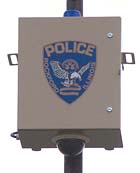
The Rockford, Ill., mesh network includes 16 outdoor boxes with mesh nodes and IP video cameras.
Crime, loitering and disorder are decreasing and residents’ sense of safety and security is increasing, thanks to a video surveillance system that is part of a wireless mesh network installed in a public housing project by the Rockford Housing Authority northwest of Chicago.
Contained in custom-built, bulletproof enclosures, the Rockford mesh network includes 16 outdoor boxes with mesh nodes and IP video cameras, plus five indoor mesh nodes for live video monitoring. Four police cars are also equipped with mobile mesh nodes so law enforcement authorities can view live video from their cars while on patrol.
Video surveillance like Rockford’s is a powerful tool for public safety, and with the increasing need for more security in airports, schools, hospitals and government buildings, the demand for video installations is growing. Being able to connect digital video cameras to computer networks and the Internet has increased the flexibility and accessibility for both collection and distribution of video data. But even though this enables cameras to be installed in more locations, the availability of network ports and cabling is still a limiting factor.
Making video surveillance easier
Wireless mesh networks can eliminate most, if not all, of the issues associated with locations that are too difficult, large or expensive to wire. By providing a wireless network backbone, mesh networks enable cameras to be installed without cables. With the ability to deploy cameras quickly and cheaply, security professionals can extend safety services with minimal additional staff or installation costs. And because the video surveillance runs on an IP network, multiple cameras can also be monitored and controlled simultaneously from any remote location via the Internet.Mesh networking is addressing a number of previously intractable public safety issues; but it is also helping to overcome the biggest problem remaining in wireless communications: the wires. Ironically, the very devices that provide wireless service to clients need lots of wiring themselves to connect to private networks and the Internet. This wiring is expensive to install and change, and deployment must be carefully planned to minimize disruption. Indeed, the many obstacles associated with wiring are now preventing or delaying the deployment of wireless applications that could deliver a competitive advantage or high return on investment – or both.
Without wires, the network becomes far more adaptable, affordable and flexible. Like the Internet, a wireless mesh network is scalable and reliable. The mesh can configure itself, allowing the installation to occur in hours.
The mesh is also largely self-managing. And with the ability to put Ethernet ports anywhere, wireless mesh offers a breakthrough approach that makes the leap from localized hot spots to fully wireless hot zones and even hot regions that span entire metropolitan areas. The bottom line: a fully wireless network that covers more area yet is less expensive than a wired one.

Video surveillance like Rockford’s is a powerful tool for public safety. Being able to connect digital video cameras to computer networks and the Internet has increased the flexibility and accessibility for both collection and distribution of video data.
True Ethernet connectivity
What ultimately determines the usefulness of wireless mesh is its ability to fit in seamlessly with existing network standards. The most ubiquitous networking standard by far is Ethernet, which is supported on virtually every networked device available today as well as a host of other networking and internetworking equipment.A wireless mesh network that provides true Ethernet connectivity will be fully compatible and interoperable with all Ethernet switching and routing protocols (including IPv6, VPN tunnels, VLANs, OSPF, BGP, RIP, Multicast, MPLS, etc.). This capability allows multiple wireless mesh networks, potentially from different vendors, to be inter-networked at Layer 2 or Layer 3, including both IPv4 and IPv6 protocols.
The ability to create an Ethernet-based “mezzanine” wireless mesh network affords the maximum level of flexibility, compatibility and interoperability. A wireless mesh essentially creates a separate “cloud” operating in either the unlicensed 2.4 GHz or 5 GHz spectrums or 4.9 GHz licensed public safety spectrum that can exist independently with its own set of services and security. Or the mesh cloud can be integrated with an existing public or private network as a subnet or overlay.
Security top priority
Security is a major concern for wireless networks and mesh networks are no exception. Traffic within the mesh must be secured and outside devices, including those that use the mesh’s Ethernet services, should be prohibited from accessing internal mesh traffic. Features like digital signatures can be used to ensure that only authorized mesh nodes can participate in the mesh.User traffic between nodes can also be encrypted to prevent wireless eavesdropping. Industry standards such as 128-bit and 256-bit AES encryption can provide very effective security comparable to the level of security provided by wired networks.
Ethernet is crucial when it comes to wireless mesh solutions in the public safety area. Newer digital cameras with Ethernet connections and support for IP provide even more flexibility because they connect to standard computer networks. The ultimate in flexibility is to connect IP cameras to a wireless network so video surveillance can be installed virtually anywhere without cabling. The best solution is a wireless mesh that provides standard Ethernet ports on every wireless node; in this way, just about every enterprise-grade IP camera can connect to the wireless mesh network.
The Texas State Fair understands this well. The fair deployed a wireless mesh network that helped apprehend vandals and a thief. Now the wireless mesh network is a staple at the fair – just like the blue-ribbon pecan pie and Budweiser Clydesdales.
Material for this article has been contributed by Magnus Gunnarsson, of Firetide, Inc., Los Gatos, Calif.

